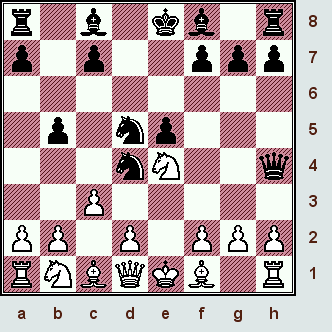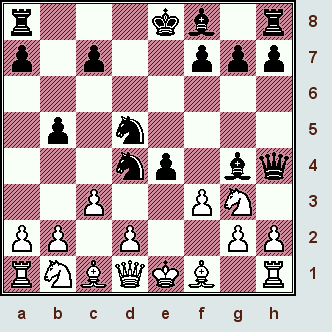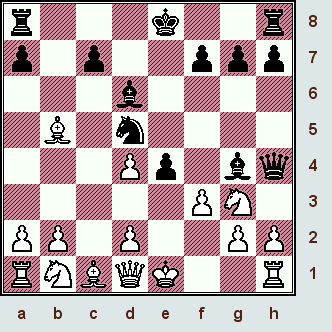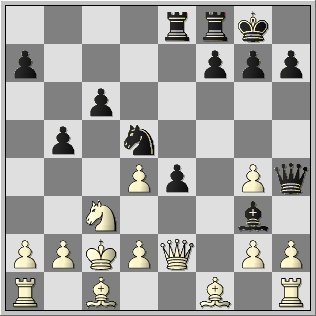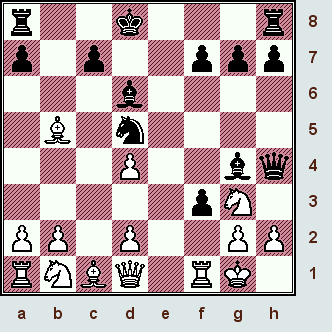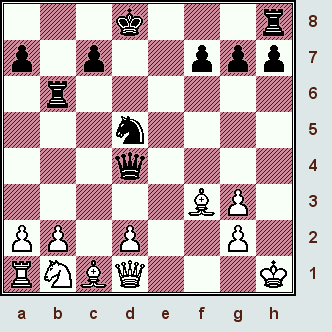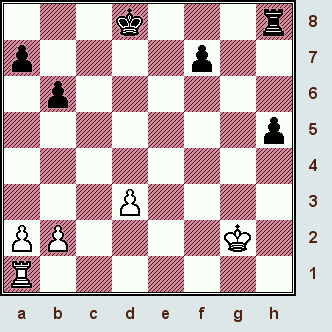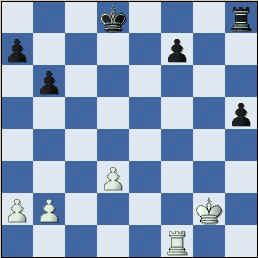All
the |
(Navigation bar
directly below.)
*******
© A.J. Goldsby, 2015.
(All rights reserved.)
****************
Click HERE
to see my
Chess Items.
****************
****************
Buy a book
from Amazon.com
(And help me out as well!)
****************
Click HERE
...
to see a list of the businesses that help to sponsor all of
my chess efforts.
|
|
Yakov Estrin (2550)
- Hans Berliner (2500)
[C57]
5th World (Correspondence) Chess Championship
ICCF Tournament, 1965-1968.
[A.J. Goldsby I]
***
The ratings are simply estimates, based
mostly on OTB results.
(These 2 were - at the time this game was played - two of the best
correspondence/postal players ... IN THE WORLD!!)
Click HERE to see this game on a JavaScript re-play page.
***
Click HERE to see a detailed explanation of the symbols that I use.
This is a great game of chess. It is - undoubtedly - one of the best "postal" games ever played.
GM
Andy Soltis - in his book, "The
100 Best," considers this
the finest game of chess for the whole of the 20th
Century!!
(It is game # 1 in his book.)
***
I have several problems with this ranking, mostly that it is like comparing apples and oranges. (Good correspondence players can spend DAYS deciding on a single move. {Some games take YEARS to play!!} Additionally, a correspondence player can move the pieces AND ... a postal player is free to consult opening books.) How can you compare this to a game where a GM has NO books, can NOT move the pieces, and often has no more than 2.5 hours to play at least 40 moves? {Additionally MANY correspondence players today are simple cheaters, they only play well because they actively use a chess computer or a strong PC chess program. Despite that this is a stark violation of the rules of all worthwhile and note-worthy correspondence chess organizations!}
But this is a pretty game of chess. We know Berliner was a very strong player, he played in at least one U.S. Championship tournament. (Also - this game was played long before computers were of any help at all to chess players.)
This
is an exceptionally fine game of chess. It contains a truly marvelous
combination. It also has one of the 20th Century's most important
...
"TN's."
(TN = Theoretical Novelty, or a new move in the opening.)
Certainly
this game would be in my list of:
"The Ten Best Postal Games Ever Played."
---> So enjoy!!
***
My
annotations here are based {primarily} on: GM A. Soltis's book: "The 100 Best."
(The 100 Best Games of The 20th Century, Ranked. {& annotated})
1.e4
e5; 2.Nf3 Nc6; 3.Bc4, {Diagram?}
The Italian Game.
[ The move 3.Bb5, leads to the respected Ruy Lopez. ]
3...Nf6;
The Two Knight's Defense.
4.Ng5,
"A duffer's move," says Tarrasch, but it is actually the sharpest and
most
testing move that Black can meet in this variation.
(According to theoretical and opening manuals.)
[ White could also play: 4.d4!?, (center); or 4.d3, (A slow
approach.);
or 4.0-0, (King safety); or
even 4.Nc3, {Diagram?}; with a fair game
in all cases. (See any good opening
book.) ]
"White's
threats to f7 force Black to take drastic action."
- GM David Bronstein. (From his book on open games.)
4...d5; ('!') {Diagram?}
This is virtually forced now.
[ Only the very brave - or the insane - play ... ... ...
the (real) "Wilkes Barre
Variation," - - - - - - - - - -
(some call it 'The Traxler Attack');
with 4...Bc5!?!?!?
See any good opening book on this
line. ]
5.exd5
b5!?;
Yet another gambit by Black, but according to most opening manuals,
5...Nd4!; is the most accurate move (order) here.
This
line is attributed to the Master, O. Ulvestad.
(Chess Review, (magazine) 1941.)
The
main line is reached after the move: 5...Na5!
(Maybe even - '!!')
This is probably Black's
best reply, and certainly the most sound move
for the 2nd player here.
(According to ALL the theoretical manuals!)
*****
[ The main line here is: 5...Na5!; 6.Bb5+
c6; 7.dxc6 bxc6; 8.Be2 h6;
9.Nf3 e4;
{Diagram} It is all
the time that is lost by White with all
these maneuvers that really make the
gambit sound for the second
player here. 10.Ne5
Bd6; 11.d4!?, {Diagram?} A major cross-roads.
(Also played is: 11.f4!?, "~") 11...exd3;
12.Nxd3 Qc7; 13.b3! 0-0;
14.Bb2 Nd5!?;
15.Nc3 Nf4!?; 16.0-0!? Nxd3; 17.Bxd3 Bxh2+;
18.Kh1 Be5;
19.Qh5 f5; "="
{Diagram}
This is an EXTREMELY complex position
here. I am not really sure
who is better. The Informant says
this position is better for White.
NIC Yearbook {survey} says unclear. MCO calls
it roughly equal.
(Most programs greatly prefer to be
White from this position!)
D. King - Zsinka; Dortmund, 1987.
[ See
MCO-14, page # 31, column # 1
and note # (e.). ]
A word of warning here. I would strongly advise a student to never
enter into these lines unless you
have studied them - in some depth! -
prior to attempting to play these
very difficult and complex lines.
(A disaster awaits anyone who tries
these lines on a casual basis!)
***
Estrin - in his landmark treatise on this
opening - recommends Black
play: 5...Nd4!;
{Diagram} This is a line originally recommended by
A. Fritz over 100 years ago.
Now 6.c3! b5!; 7.Bf1! Nxd5!; "~"
{Diagram?} when we have simply
transposed back into the game. ]
*****
6.Bf1!,
This move is given an exclam in most theoretical manuals.
[ 6.Bxb5!? Qxd5; "<=>" Black gets play. ]
The
next few moves are considered sharpest and best,
- according to opening theory.
(If this line fails, White should strongly consider another 7th move,
however.)
6...Nd4!; 7.c3! Nxd5!;
Black has very active play here - consult any good book on this
very complicated opening.
We
have actually transposed out of the Ulvestad lines, and now
are in the
main line of "The Fritz Variation." (5...Nd4!)
8.Ne4!?,
(Maybe - '!') {Diagram?}
This move is given an exclam in many opening books ...
Suffice it to say that White has a slew of playable alternatives at this point.
Note:
Ne4!? does involve a further loss of time by White.
(But it is also the most solid move ... and it avoids any weaknesses ...
or an opening of the game.)
[ All of the following moves are playable for White:
8.h4!?, or 8.Nxf7!?, or 8.cxd4!?, or
8.Nh3!?
White has a fair game in each case. ]
8...Qh4!!;
(HUH!!!???) {Diagram below.}
One of the more shocking and strong discoveries in all of chess practice.
(A Theoretical Novelty?)
(It is
also a violation to the rule-of-thumb every beginner has heard:
"NEVER
bring your Queen out early!!!).
|
|
Black's Queen sortie is seemingly justified by
several factors. The most
important of these is White's many losses of tempi,
and the fact that
the 1st player simply has no way to attack the rogue Black piece on h4.
I am not sure if Berliner was the first to play this move in an actual game
or
not, but 8...Qh4; had been analyzed by several Russian chess
magazines - prior
to Berliner's use of this wild move.
(This variation is named after Berliner in
at least one of my books
on the Two Knights Opening.)
'!' - GM A. Soltis.
9.Ng3,
(!)
This is nearly forced here, according to several opening books.
[ 9.d3!? ]
9...Bg4!;
10.f3 e4!!; (Theoretical Novelty)
{Diagram below.}
This extremely powerful
move was a TN and Berliner's discovery.
|
|
Now
the game ceases to be ruled by positional guidelines ... and one
could drown a modern super-computer in the ensuing complications.
(To his credit, Berliner has calculated these lines VERY well ...
and to an almost unbelievable depth.)
'!!' - GM Andy Soltis.
[ The old
'book' line said Black had to play ...Nf5:
10...Nf5!?; 11.Bxb5+!,
(Qe2!?) 11...Kd8; 12.0-0
Bc5+;
13.d4! exd4; 14.Ne4!, "+/"
{Diagram?}
This clearly favors White,
according to GM A. Soltis. ]
11.cxd4 Bd6;
12.Bxb5+, {See the diagram, just
below.}
Seemingly ... the best ... and the obvious move here for the first party.
|
|
Yet it transpires that White has a
different move here ... one that may
win for White, and is NOT even considered by many chess books!
[ One kibitzer, (RandomVisitor, on the CG.com website); suggested
that I look at a possible alternative move at this juncture.So let's examine it, shall we?
12.Qe2!? 0-0; ('!')
The first choice of several programs, (but I may not have given them
enough time to do a really thorough search). But!! ... it seems a wise
course of action (here) for Black to remove his King from the center.( The continuation of: </= 12...Be6?!; 13.Qf2! exf3; 14.Bxb5+,
14...Kf8!?; 15.Qxf3 Rb8; 16.Be2 Qxd4; 17.Nc3 Nb4;
18.Kf1 Nc2; 19.Rb1 Qe5!?; 20.d3 Nd4; 21.Qf2, '±' ("+/-")
seems to leave Black with inadequate compensation for the
piece here. )13.fxg4, (Best?)
Again - this seems like an obvious capture.( The continuation of: (</=) 13.Qf2!? exf3!; 14.gxf3,
14...Nb4!?; 15.Na3!? Rae8+; 16.Ne4 Qh5!; "<=>"
cannot be recommended ... as Black seems to have
too much play for his material deficit. (White can also
consider taking the Bishop on move fifteen in this
variation, but - to me - it does not appear to make that
much difference, as Black still has very good play.) )13...Bxg3+;
This looks like Black's only really decent move here.*** *** *** *** *** *** *** *** *** *** *** *** *** *** *** *** *** *** *** ***
( Less impressive was: 13...Nb4!?; 14.Kf2!! Bxg3+;
Once again - the indicated capture.( I also looked at:
14...Nc2!?; 15.Kg1 Nxa1!?; 16.Nf5 Qf6; 17.d3, "+/-" )15.Kg1! Bd6, (Box?)
Fritz considers this forced.( Just plain wrong would be:
</= 15...Nc2?; 16.hxg3 Qe7; 17.Nc3, "+/-"
and even if White loses the 'Ox' in the corner, White will trap
the N - and win it. This will give White three minor pieces
for a Rook ... )16.Nc3, '±' (Maybe "+/-")
and if White untangles his position, {and remains a piece ahead};
he should be able to win. )*** *** *** *** *** *** *** *** *** *** *** *** *** *** *** *** *** *** *** ***
(White's next move looks to be best. The first player is two pieces
ahead, and must give one back to gain a certain level of piece
organization.)14.Kd1 c6; (hmmm) {Box?}
(This looks to be correct, I doubt that giving away the b-Pawn will
really help Black's cause.)15.Nc3 Rae8; 16.Kc2, "+/=" ('±') {See the diagram below.}
when White appears to be clearly better. (However, I will admit that
I am a little uncomfortable with Black's level of play here. Yet the first
player remains a piece ahead, the onus is on Black to try and improve
in this variation.)
(Analysis position after 16.Kc2.)
Analysis - of this line - on Monday; May 15th, 2006. (I spent over half a day
exploring these wild lines ... and I used several different programs as well.)These lines are exceedingly difficult and complex, somehow I doubt if this is
the last word on this subject ... (In closing, I should also point out that most
programs consider the final position, in my main line here, to be flat-out
winning for White.)Click here to see this game on the CG site, the comments are full of
some interesting analysis of the various possibilities in this contest. ]
12...Kd8!;
This
whole line was very obviously prepared by Black in advance.
His last move,
"shows the strength of Black's idea."
- GM Andy Soltis.
13.0-0!,
This is best, according to Soltis.
'!' - GM Andy Soltis.
[ 13.Qb3!?
Bxg3+; 14.Kd1?! Be6; 15.Bc6 exf3!!;
16.Bxa8? fxg2; "-/+" {Diagram?}
and Black is winning
here. - IM H. Berliner. ]
13...exf3; {See
the diagram given, just below.}
Just out of curiosity,
I checked this position against my database ... and
several on-line db's as
well. There have been over 100 (!!!) examples
... of this line at the Master level,
yet almost none between GM's that I
could find. (In this particular sub-variation.)
|
|
White has won the overwhelming majority of these games.
See the game:
GM G. Sax - S. Wagman; Montecatini
Terme Open, 1998.
(Drawn in 42 moves.)
14.Rxf3?!,
(Maybe - '?')
Soltis gives no mark of any kind to this move. But it appears to be
very bad.
(White appears to have at least TWO moves that are distinctly better
than
this one!!)
[ 14.Qb3!, "+/" - GM A.
Soltis.
(14...Nb4!; 15.a3?!, Rb8; or
15.Rxf3, c6!);
---> Also maybe better than the game, was: 14.Qe1!?, "+/"
{Diag?}
- LM A.J. Goldsby I
(White is clearly better after either Qb3! or Qe1!?) ]
14...Rb8!,
This is easily the
sharpest move for the second player. Despite Black's
failure to castle he finds very creative ways to involve all of his pieces
in the attack.
(...Rb8; to ...Rb6; and then across the 3rd rank to attack White's King.)
[ 14...Nf4!? ]
15.Be2?,
"White's only error in this game." - GM Andrew Soltis.
(Not!)
'?' - GM A. Soltis. '?' - GM John Nunn. '?' - FM Graham Burgess.
(About
a dozen well-known authors have harshly criticized this move.)
[ The
best line probably was: >= 15.a4!, "+/"
(Maybe "+/-") {Diag?}
which several
computers feel is winning for White.
{Soltis does not even mention this move.}
(The analysis of this line is very long and tedious. It should be enough
to
mention the fact that I found at least 3 errors on the Mammoth
Book's analysis
of these very complex lines.);
GM A. Soltis says White should play the
continuation:
15.Nc3!?, Now
Black should play: 15...Nxc3; 16.dxc3 Rxb5;
17.Qd3 Rh5!; "<=>" {with
counter-play} {Diagram?}
but Black has a ton of play here. {A.J.G.}
]
15...Bxf3;
16.Bxf3
Qxd4+; 17.Kh1 Bxg3!; 18.hxg3,
18...Rb6; ('!') "=/+" {See the diagram just
below.}
Black already
threatens ...Rh6+, winning the game.
|
|
19.d3 Ne3;
('!') 20.Bxe3 Qxe3; 21.Bg4!,
White attempts to block key lines that lead to his King.
'!' - GM A. Soltis.
[ Another postal game in 1996 saw the line:
21.Nc3!? Rh6+; 22.Bh5 g6; 23.g4 gxh5; 24.g5
Qxg5; "-/+" {D?}
... "and White did not survive to reach the
endgame."
- GM A. Soltis. ]
Soltis also gives Black's next move an exclam
as well.
21...h5!; 22.Bh3 g5; 23.Nd2!, {Diagram?}
"White's best chance for survival." - GM A. Soltis.
(White threatens Nc4, winning back an exchange.)
[ White can also play: 23.Qf3!?; or 23.Nc3!? ]
The next series of moves are all best or forced, according to
...
GM
Andy Soltis.
23...g4; 24.Nc4 Qxg3; 25.Nxb6 gxh3; 26.Qf3!
hxg2+; 27.Qxg2 Qxg2+;
28.Kxg2 cxb6!!; "-/+" {See
the diagram given - just below here.}
Black is clearly
better here.
|
|
"What makes this an immortal game is the accuracy required
in
all of its phases." - GM Andrew Soltis.
'!!' - GM A. Soltis.
[ If 28...axb6!?; then 29.a4!, followed by b4.
(White will make a passed a-pawn. ]
****************************************************************************************
Strangely enough, this game has resolved itself to a R+P ending.
This ending
is conducted by Berliner, as though Capa himself was looking over Black's
shoulder, insuring he always made the
best possible move - every single time!! (I can offer no higher praise.)
29.Rf1 {See the diagram given, just below.}
White plays as well as he can, but at this point ... his prospects are, well ...
VERY bleak. (To say the least!)
(Below is the actual position.)
|
|
What follows now is one of the best and more instructive R+P endings that have ever been played.
29...Ke7;
('!') 30.Re1+ Kd6!; 31.Rf1 Rc8!; (Maybe
- '!!') {Diagram?}
Black {temporarily} sacrifices a pawn, but greatly improves his
overall position.
'!' - GM Andy Soltis.
32.Rxf7 Rc7!;
33.Rf2[],
This is forced, White can not exchange Rooks in this position.
(Nor can he allow Black to play ...Rc2+)
[ White should not even seriously consider playing:
33.Rxc7? (??) 33...Kxc7; 34.Kh3
Kd6; ("-/+") {Diagram?}
and Black simply marches up the board
and eats all the
White Pawns. Work it out! ]
33...Ke5;
('!') 34.a4?!,
(Maybe -
'?')
"This shortens the game by at least 10 moves," says GM Andy Soltis.
'?' - GM J. Nunn & FM Graham Burgess.
(Other authors have {harshly} criticized this move as well.
GM Salo Flohr described this move as basically a blunder.)
In Estrin's defense, he may have
thought he could force a theoretically
drawn
R+P ending. And as GM Soltis points out, that even with the best
defense, Black will probably win anyway. So the point may be moot.
[ MUCH better was the
line: 34.Kg3 Kd4; 35.Kh4 Kxd3; 36.Kxh5 Rc2!;
37.Rf7 Rc5+; 38.Kg4 Ra5;
39.Rf3+ Kd2!!; 40.b3 Ra3!, "/+" {Diag?}
Black is clearly better and will
probably win. (Line by GM A. Soltis.) ]
34...Kd4;
35.a5 Kxd3; 36.Rf3+
Kc2; 37.b4 b5!; ('!!')
Black had to preserve at least one of his Q-side
pawns to have any
winning chances.
'!' - GM Andy Soltis.
(Strangely enough,
the ending of 2RP's + R + K vs. K + R ... is ........
considered drawn!!
- - - See any good book on
Rook-plus-Pawn endings.)
38.a6 Rc4;
39.Rf7 Rxb4; 40.Rb7;
GM John Nunn says that this move is forced.
[ Black has a very simple
win after Rxa7, viz: 40.Rxa7 Ra4;
41.Rb7 b4; 42.a7 b3; 43.Rc7+ Kb1; 44.Rb7
b2; 45.Kf2,
45...Ka2; "-/+" {Diagram?}
Black is winning here.
(White must give up his Rook to prevent the promotion of
Black's QRP. ]
40...Rg4+;
41.Kf3 b4; 42.Rxa7 b3;
White Resigns. (0 - 1)
A truly great game of chess.
(But not worthy to be
ranked as highly as Soltis ranks this particular
contest, IMOHO.)
*****
BIBLIOGRAPHY:
(The following are the 2 best books for info and analysis of this
game.)
# 1.) "The 100 Best," by GM Andrew Soltis.
# 2.) [The
Mammoth Book of] "The World's Greatest Chess
Games," (# 55);
by GM
John Nunn, GM John Emms, & FM Graham Burgess.
(SEVEN!!! {7} pages of very
deep, and meticulous, 2-column
analysis of this fantastic game.)
Copyright (c) A.J. Goldsby I. Copyright (©) A.J. Goldsby, 2002.
0 - 1
(Code initially) Generated with ChessBase 8.0
This is a GREATLY/MASSIVELY shortened version of this game ... rather than the original version in my ChessBase files. (To convert that version of this game to a web page was simply too daunting a task!)
I actually developed this version specifically for my web page. (Why develop pages ... with super-complicated sub-sub-variants ... that take almost forever to check and format ... if no one is going to ever look at these ... or even ever go over the variations? PLUS - I want to annotate hundreds - or even thousands! - of chess games. I will never accomplish this goal if I do not become a little more circumspect in the amount of time I devote to one page. Additionally ... many people have complained my pages take far too much scrolling! And I want a page that highlights only the most interesting variations!)
If
you would like to obtain a copy of this game, for your own personal study,
..........
please contact me. (HINT: It
probably won't be free.)
Click HERE to return to my "Best Games" page.
Click HERE to go to (or return) to my "Geo-Cities" home-page.
(Or click the "Back" button on your web browser.) *** Last edit or save on: 07/14/2012 .
Copyright (c) A.J. Goldsby I
Copyright (©) A.J. Goldsby, 1995 - 2008.
Copyright © A.J. Goldsby, 2009. All rights
reserved.

